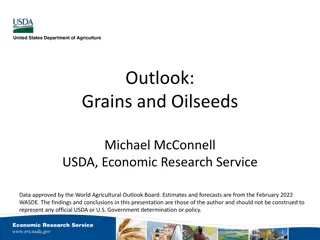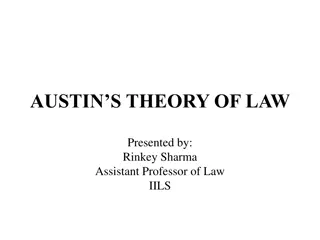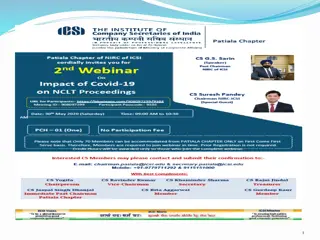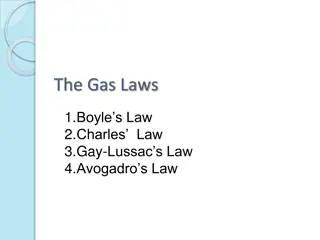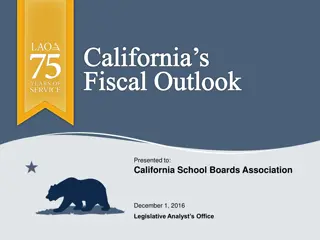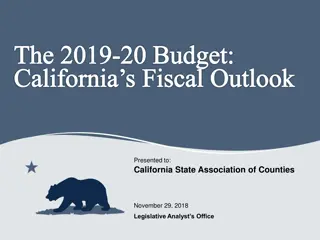Overview of AGOA: Law, Advantages, and Future Outlook
AGOA, the African Growth and Opportunity Act, offers unilateral trade preferences similar to GSP, with a focus on textiles and apparel. The law, signed in 2000 and extended through 2025, provides duty savings and requires specific origin rules for different product categories. Special document requirements apply to textiles under AGOA, emphasizing the importance of accurate documentation for trade benefits. The law's advantages over other trade agreements lie in its inclusion of sensitive products like textiles and apparel, providing opportunities for countries like Ghana and Benin. Understanding the classification and duty considerations for products like uniforms and scrubs is essential for importers to benefit from AGOA.
Download Presentation

Please find below an Image/Link to download the presentation.
The content on the website is provided AS IS for your information and personal use only. It may not be sold, licensed, or shared on other websites without obtaining consent from the author.If you encounter any issues during the download, it is possible that the publisher has removed the file from their server.
You are allowed to download the files provided on this website for personal or commercial use, subject to the condition that they are used lawfully. All files are the property of their respective owners.
The content on the website is provided AS IS for your information and personal use only. It may not be sold, licensed, or shared on other websites without obtaining consent from the author.
E N D
Presentation Transcript
African Growth & Opportunity Act Overview of Law Advantages Outlook for the Future Jan Forest May 8 2019 Sponsored by
Overview of Law AGOA provides unilateral preferences similar to GSP Signed into law May 18, 2000 and extended through 2025 in 2015 with strong bipartisan Congressional support AGOA adds 1,800 products to GSP including import sensitive products (such as textiles and apparel) Textiles and apparel are eligible under special origin rules in Chapter 98 of the HTSUS 2
Rules of Origin for AGOA Non-textile goods are subject to the GSP rules of origin Wholly produced or substantially transformed 35% local processing requirement Textiles and apparel are subject to special origin rules under Chapter 98, Subchapter XIX of the HTSUS Only countries with an effective visa system are eligible (U.S. Note 1 to Chapter 98) Goods must fit within one of the 10 categories listed on the AGOA Textile Certificate of Origin 35% local processing requirement does not apply 3
Special Document Requirements for AGOA Textiles AGOA Certificate of Origin (handout number 1) Invoice stamped with original AGOA visa (handout number 2) Need separate visa stamp on invoice for each category of goods Importer must make written declaration by including Chapter 98 subheading on entry documents 4
Advantages under AGOA Provides a large duty saving compared to other regions of the world GSP does not include textiles/wearing apparel NAFTA has restrictive yarn forward rule and change in heading DR/CAFTA has yarn forward (and sometimes fiber forward) in addition to change in heading rule Primary advantage of AGOA over GSP is inclusion of sensitive products such as textiles and apparel The procedure has been tried and tested in Ghana and Benin The required visa stamp and authorized signatures are in place 5
Classification and Duty Considerations for Uniforms, Scrubs Product Style Classification considerations Gender HS codes Duty Top Uniform tops classified as: Shirts (left over right) Blouses (right over left or unisex) Men 6205.30.20 29.1 c/kg + 25.9% Uniforms Women 6206.40.30 26.9% (All 65P/ 35C) Bottom Uniform bottoms classified as: Pants/Trousers Men 6203.43.90 27.9% Women 6204.63.90 28.6% Chef jacket Men 6205.30.20 29.1 c/kg + 25.9% Classified as men s shirts or women s shirts (unisex) Women 6206.40.30 26.9% Top Scrub tops classified as shirts/ blouses Men 6205.30.20 29.1 c/kg + 25.9% Scrubs (All 65P/ 35C) Women 6206.40.30 26.9% [Below waist with pockets may be 6211.33.90 (men) or 6211.43.90 (women) both 16%] Bottom Scrub bottoms classified as pants Men 6203.43.90 27.9% Women 6204.63.90 28.6% 6
Classification and Duty Considerations for Pajamas Product Classification considerations Style Gender Fabric HS Duty Pajamas Pajamas are generally two-piece garments worn for sleeping; tops and pants are classified as pajamas if they are marketed as sleepwear and designed for a private activity; they are considered loungewear (classified in the higher duty-rate provisions for shirts and pants) if they are designed for a more public activity such as socializing at home with friends, walking the dog, etc. Nightgown Women Knit cotton 6108.31.00 8.5% Woven cotton 6208.21.00 8.9% Robe Men Knit cotton 6107.91.00 8.7% Woven cotton 6207.91.10 8.4% Women Knit cotton 6108.91.00 8.5% Woven cotton 6208.21.00 7.5% Knit top & Flannel pants Men Knit cotton 6107.21.00 8.9% Woven cotton 6207.21.00 8.9% Women Knit cotton 6108.31.00 8.5% Woven cotton 6208.21.00 8.9% 7
Classification and Duty Considerations for Jackets Product Style Fabric Gender HS code Classification considerations Duty Jacket Soft shell Synthetic Men 6201.93.47 Recreational performance/ water resistant 7.1% 6201.93.49 Recreational performance/ not water resistant 27.7% 6201.93.60 Not recreational performance/ water resistant 7.1% 6201.93.65 Not recreational performance/ not water resistant 27.7% Women 6202.93.07 Recreational performance/ water resistant 7.1% 6202.93.09 Recreational performance/ not water resistant 27.7% 6202.93.48 Not recreational performance/ water resistant 7.1% 6202.93.55 Not recreational performance/ not water resistant 27.7% Summary: For non water resistant soft shell jackets, 27.7% duty advantage under AGOA 8
Classification and Duty Considerations for Kids Clothing Product Classification considerations Style Fabric Gender HS Duty Kidswear The expression "babies' garments and clothing accessories" means articles for young children of a body height not exceeding 86 centimeters Poloshirt 100% cotton pique Boy 6105.10.00 19.7% Girl 6106.10.00 19.7% Leggings 95%C/ 5% span 6104.62.20 14.9% Jeggings 60%C/ 35%P/ 5% span 6104.62.20 14.9% Boys classified the same as mens Chinos 100%C Boy 6203.42.45 16.6% Girls classified the same as womens Girl 6204.62.80 16.6% Unisex classified as womens 9
Case Study Inquiry from company was to ask whether articles imported and then sold to religious institutions qualify for duty-free treatment under 9810 Stoles to wear over clothing Baptismal stoles and bibs Collars and collarettes Main findings Prayer shawls and head wear used for public or private observances are covered under 9810, but customs ruling interprets this very narrowly Chapter 71 has provisions for religious articles worn on apparel or carried by the person, dutiable at 3.3% or 3.9% All of the articles in this case qualify as wearing apparel under Chapter 62 and are duty free under AGOA 10
Outlook for the future AGOA in effect until 2025 Post-AGOA trade relationship Transition from aid-based assistance to trade-based assistance U.S. looking for increasing self-reliance FTA with U.S. would lock in benefit of AGOA Ghana being considered for model FTA for all of Africa 11
Appendix 12
Labeling Requirements for Textiles Country of origin marking Every article of foreign origin imported into the US must be legibly marked with the with the English name of the country of origin prior to shipment unless an exception from marking is provided Textile labeling requirements (handout 3) FTC regulations govern labeling of textiles with: Fabric content Country of origin Name of manufacturer or importer 14





